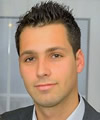 By Georgios Petalidis, Katsidonis Pantelis & Sia EE.
By Georgios Petalidis, Katsidonis Pantelis & Sia EE.
This project involved bringing together two hotels, namely the Boutique 5 Hotel & Spa and Princess Andriana Resort & Spa, into the same network using KNX. Boutique 5 Hotel is one of the few five-star Adults Only hotels located in Kiotari, southern Rhodes. Princess Andriana Resort & Spa is also located in Kiotari, and provides private pools, an art spa, various restaurants, bars and many more facilities.
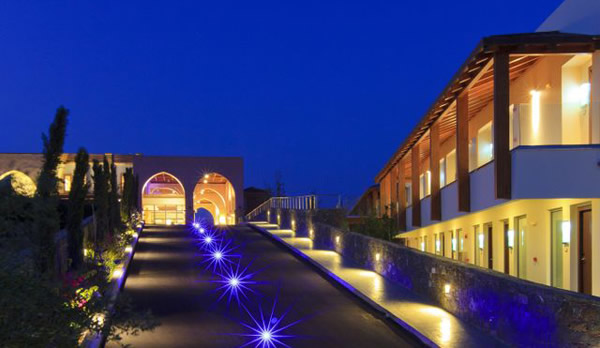
The brief
The brief was to provide energy-efficient control of lighting and air-conditioning using state-of-the-art technology that is convenient and easy-to-use for both customers and staff. In addition, functions such as alarm notification, and local and remote monitoring were to be integrated.

Lighting
A key feature of these hotels is lighting control, and each hotel section has its own special features, so we needed to adopt various techniques in order to accommodate the different requirements of the various spaces.
In the outdoors areas, the lighting is activated whenever the ambient brightness drops to an insufficient level. This is achieved by using the corresponding luminance measurement in lux, which is divided into six measured levels, which in turn activate different circuits of hotel sections, such as swimming pools, communal areas, etc.
The external lighting is switched off either gradually by programs, or according to the sunrise, when it is turned off along with everything else that has been left on by the users. All of this is accomplished using KNΧ, and results in huge saving in terms of energy consumption. Room lighting is switched off when the guest leaves the room, corridor lighting is activated only by the presence of someone.
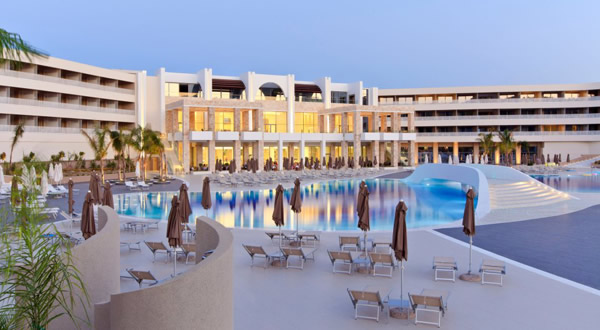
We used weather sensors with corresponding desired luminance levels, which can be adjusted and controlled by visualisation or mobile phone.
Both dimming techniques (indirect 0-10V and direct 230V) have been applied to the meeting rooms, spa and bar in order to set the atmosphere of the room. In the communal corridors, a combination of dimming and presence detection has been implemented. This adjusts the lights according to the guest’s direction, activating the lighting circuits ahead, whilst switching off the ones behind, resulting in a magical effect along the full length of the corridors. We used KNX presence detectors and brightness flow measurement to achieve this effect.
In individual areas, there is the possibility of local and central control, with RF controls as well as local push buttons that provide on/off and dimming scenes.
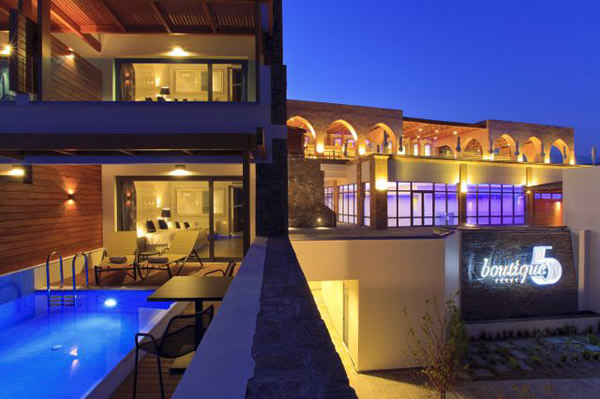
Air conditioning
Another key element that contributes to energy efficiency is the control of the hotel’s air conditioning system. Since our aim was not only to maximise the comfort of the hotel guests, but to help make savings wherever possible, it was important that there should be as little waste as possible.
To this end, guests’ rooms are fully controlled in order to prevent the unnecessary use of air-conditioning. It is switched off either when there is no presence or when a window is open. The only exception is during the check-in process, when the receptionist is able to activate the air-conditioning in the room before the customer inserts their room key, in order to provide a feeling of hospitality and care in a friendly environment.
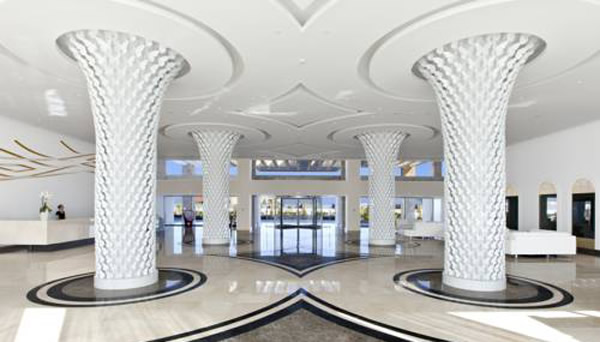
The reception staff also have control over the temperature range. Indeed the air-conditioning and ventilation control of the whole project is achieved by the visualisation system.
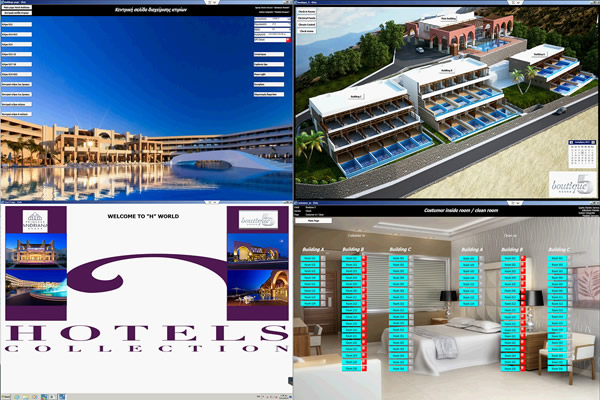
Shading
In sun-lounge areas such as the restaurant and bar, we applied a shading system whereby the sunshades are activated either gradually depending on the location of the sun or through the RF controller when the user intervenes. It is also possible to adjust the shades individually depending on the user’s requirements.

In order to achieve control of roller shutters and curtains, weather sensors and time schedules are used. As mentioned before, each room has special features beyond the central control, that allow for local control. In the meeting space, for example, there is the possibility to create lighting scenes.

Safety
This project is divided into two main areas, one for each hotel. Therefore an important factor is the alarm system as well as the immediate notification of technical personnel about problems that occur in the facility. KNX technology has enabled the recording and immediate notification of possible damage to the entire size of the project. Updating and recording is done in the visualisation system as well as in personal mobile phones. The control is achieved in all remote electrical panels by checking all the fuses on each board and the loads. The system also introduces alarms from the KNX devices, where they also notify the reception staff for immediate response. All of this results in customer care, fast service and immediate repair of the damage.
The visualisation software is Elvis 3 from IT GmbH. It is installed on the hotel server and checks and records all of the functions of both hotels. Access uses the client method, and the server consists of 36 datapoint types, 30 process ports and 15301 datapoints. The terminal consists of 116 pages and 14,144 controls. Apart from Elvis 3, there is also a visualisation application on Android tablet and mobile for instant access to the system via Wi-Fi and VPN.
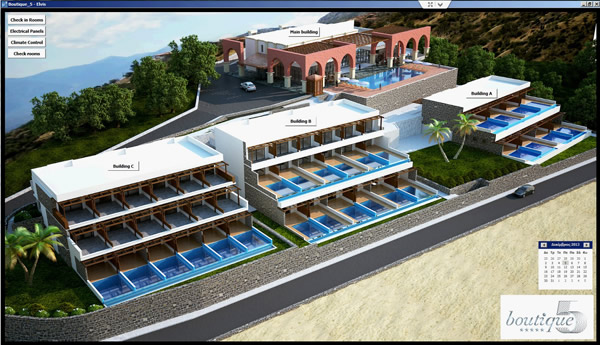
Other functions
We were also tasked with integrating other functions such as technical monitoring, measurements, project visualisation, interconnection with other systems and remote monitoring.
Technical monitoring is achieved via the KNX system, where we now have the possibility of centrally controlling the entire hotel group. Errors, alerts, scripts, and controls are now performed via the KNX system where they can be displayed on the host, a tablet, or even mobile phones, as long as they have access to the server. It is worth mentioning that a total of 9808 KNX addresses are controlled.
Smart measurement is done through specific devices which read and transmit the power consumption of each load line by measuring the output current. As a result, we are able to determine the consumption of each circuit and activate or deactivate it accordingly. Also, through this measurement, we know if there is an error in the line, since the system knows what the normal operating range limits are.
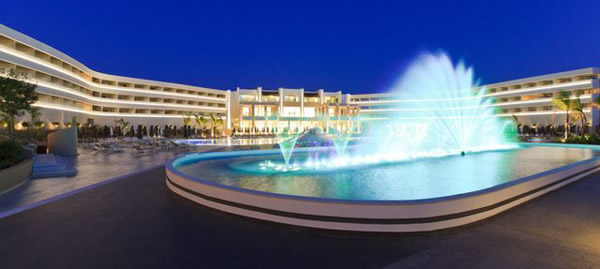
For greater control, it is essential that there is communication between the systems. The air-conditioning system uses a LON communication protocol, so the KNX system interfaces with it via an adapter from Intesis and a Daikin board. This allows it to exchange information and control the air-conditioners.
Remote monitoring is essential for the smooth operation of the project, so our company has full access to both ETS5 and all the other software using a Cisco VPN. And in this area, KNX has shown its superiority to other solutions that require a central controller.
A similar levels of remote control has been given to hotel technicians, although this is not via ETS5.
Conclusion
In my opinion, using KNX for such a project is a no-brainer. It is impeccable technology that provides us with all of the functionality we require, including remote supervision, checking and debugging. It also provides the hotel with state-of-the-art technology that is also impressive to the customer. Finally, apart from the benefits of responsive customer service and flawless operation, the most important thing about KNX is the energy saving it facilitates and the resultant saving of money. The combination of all of these advantages make the use of KNX essential.
Equipment list
(This list does not include some of the products used, such as power supplies, serial devices etc).
ABB
70 x 2CDG 110 071 UK/S32.2 Universal I/O-Colour Series 72.00mm
R0011 Concentrator, 32-fold,MDRC
Albrecht Jung
1 x 2308.16REGHM 8-gang switch actuator 16A SE 144.00mm
KNX Association
36 x DumProd 02001 Dummy Product for BIM M112
Siemens
11 x 5WG1 114-2AB02 Bus coupling unit UP 114/02
26 x 5WG1 125-1AB21 Power supply unit N 125/21(230V/640mA)
1 x 5WG1 125-1AB22 Power supply unit N 125/22 (230V/640mA)
26 x 5WG1 146-1AB02 IP-Router N 146/02
5 x 5WG1 148-1AB11 Interface N 148/11 USB
2 x 5WG1 151-1AB01 IP Viewer N 151
2 x 5WG1 220-2-B31 Push button interface UP 220/31
1 x 5WG1 220-2AB03 Wall switch interface UP 220/03
1 x 5WG1 257-3AB22 Weather Station GPS AP 257/22
142 x 5WG1 258-2-B11 Presence detector – brightness sensor UP 258/E11
10 x 5WG1 262-1EB11 Binary input device N 262E11
4 x 5WG1 263-1EB01 Binary input device N 263E01
25 x 5WG1 263-1EB11 Binary input device N 263E11
12 x 5WG1 2xx-2AB BTM Wall Switch UP22x/UP24x/UP28x
4 x 5WG1 347-1AB02 Logical Link Device N 347
1 x 5WG1 350-1EB01 IP Controller N 350E
1 x 5WG1 372-5EY0 Time switch 4-Channel REG 372, REG 372/02
3 x 5WG1 450-7AB03 IR Receiver Decoder S 450
1 x 5WG1 501-1AB01 Combi Sunblind Actuator N 501
6 x 5WG1 502-1AB02 Combi Switching Actuator N 502/02
13 x 5WG1 513-1AB11 Switching Actuator N 513/11
2 x 5WG1 520-2AB31 Blind actuator UP 520/31
1 x 5WG1 523-1AB03 Roller shutter switch N 523/3
9 x 5WG1 523-1AB11 Venetian blind actuator N 523/11
9 x 5WG1 526-1EB02 Switching / Dimming Actuator N526E/02
41 x 5WG1 527-1AB31 Universaldimmer N 527/31
1 x 5WG1 528-1AB31 Universaldimmer N 528/31
1 x 5WG1 562-1AB01 Binary output N 562
18 x 5WG1 562-1AB11 Switching Actuator N 562/11
4 x 5WG1 567-1AB01 Switching actuator N 567/01 (8A)
2 x 5WG1 567-1AB11 Switching actuator N 567/11 (8A)
38 x 5WG1 567-1AB12 Switching actuator N 567/12, (2A)
18 x 5WG1 567-1AB22 Switch device N567/22 (16 Channels)
10 x 5WG3 140-2-B-1 Coupler wave / instabus UP 140
45 x 6BK1700-0BA00LOGO! V3 Colour 36.00mm
Siemens HVAC
315 x RDF301 RDF301 Room Thermostat
Georgios Petalidis is the Chief Electrical Engineer, KNX Partner and Siemens BMS Partner for Katsidonis Pantelis & Sia EE, electrical designer and installer of low- and medium-voltage KNX and BMS systems.













